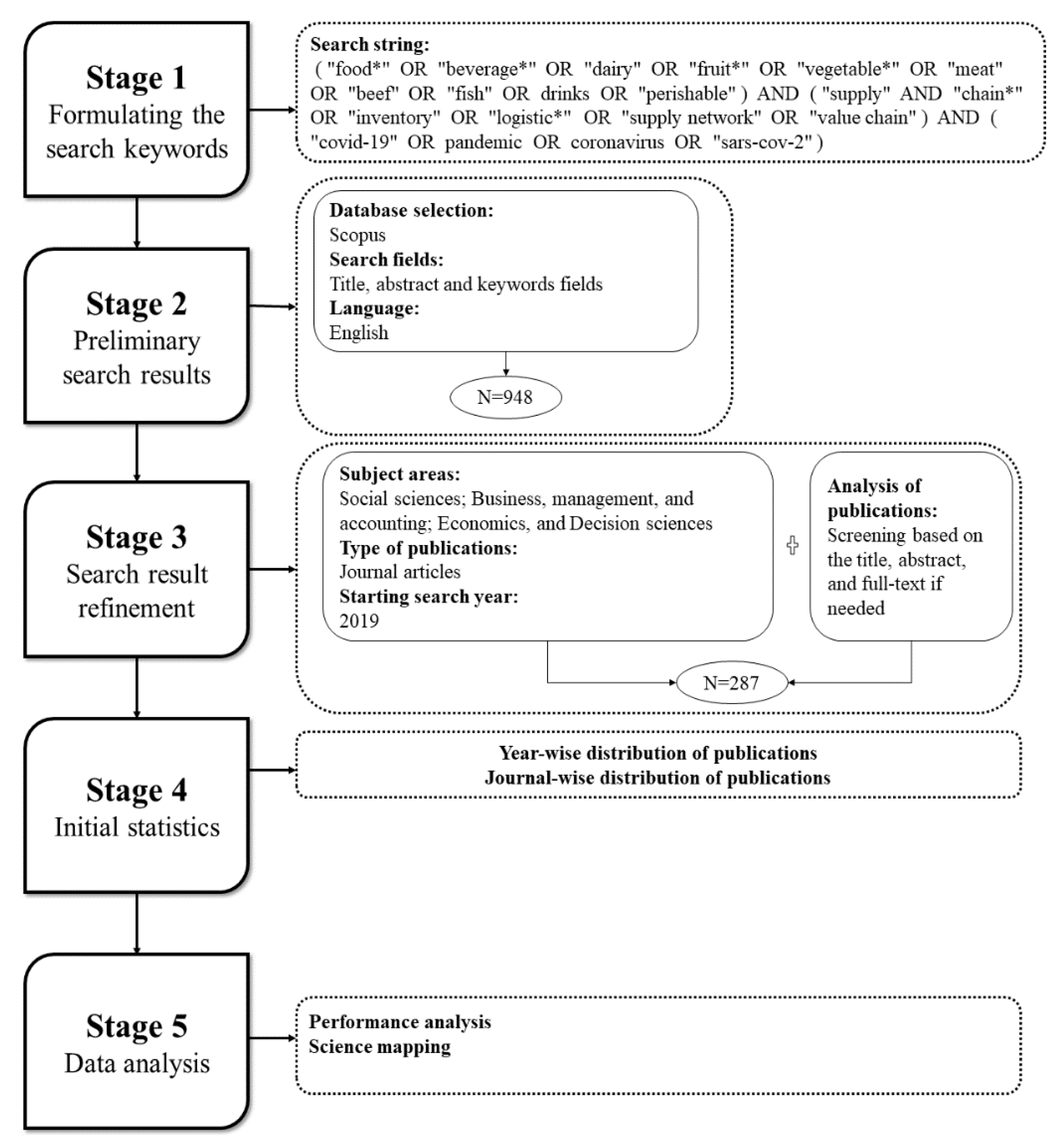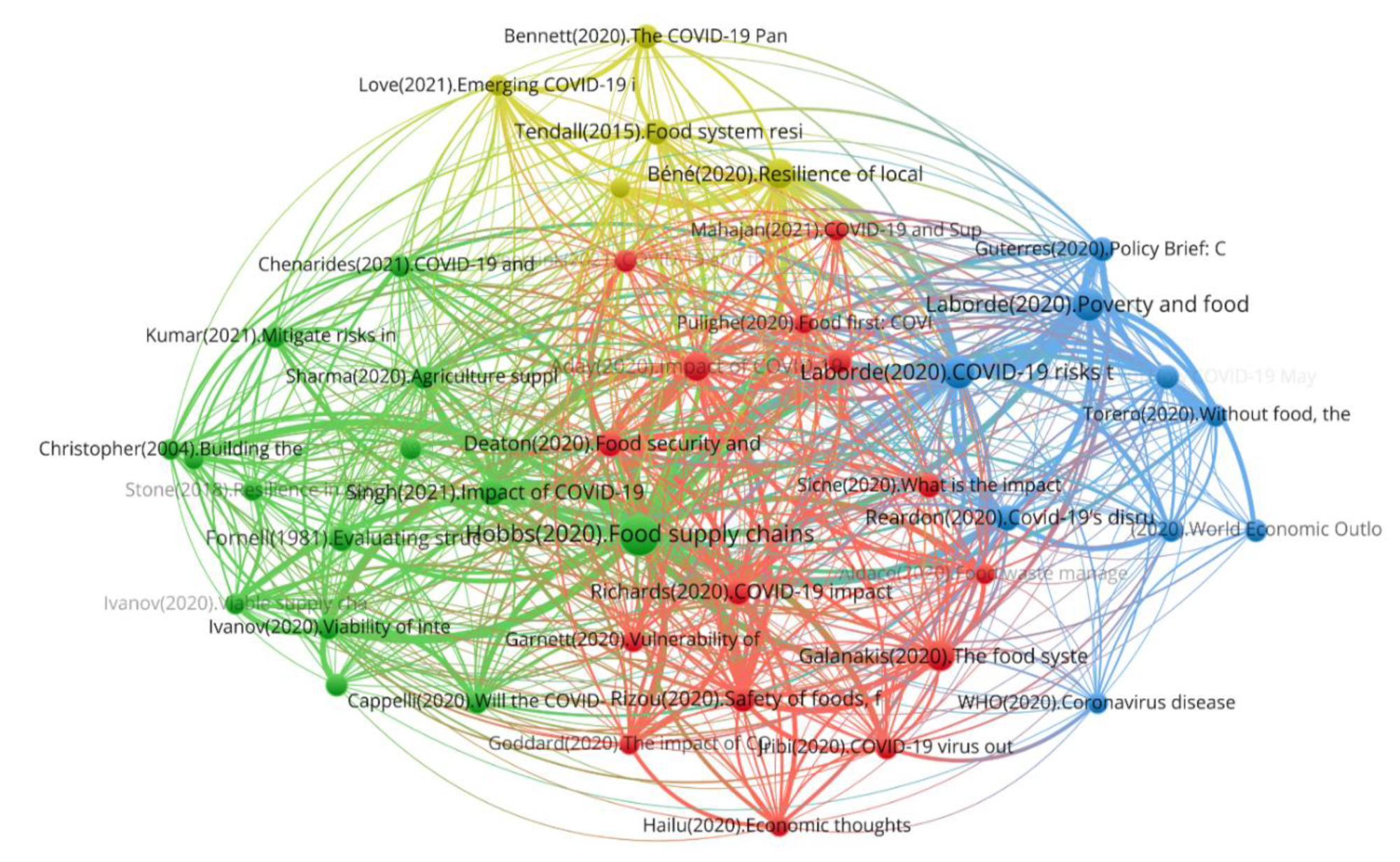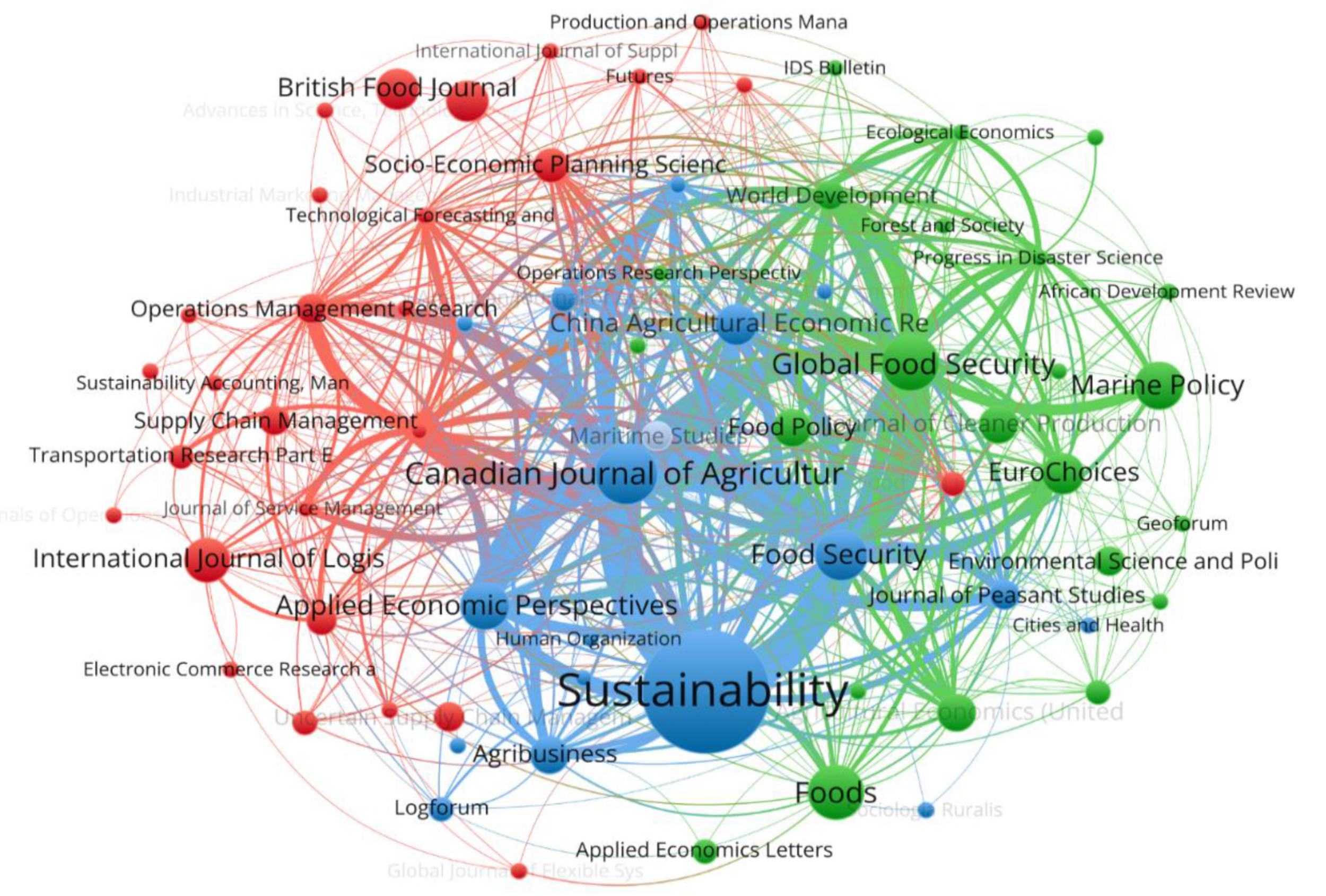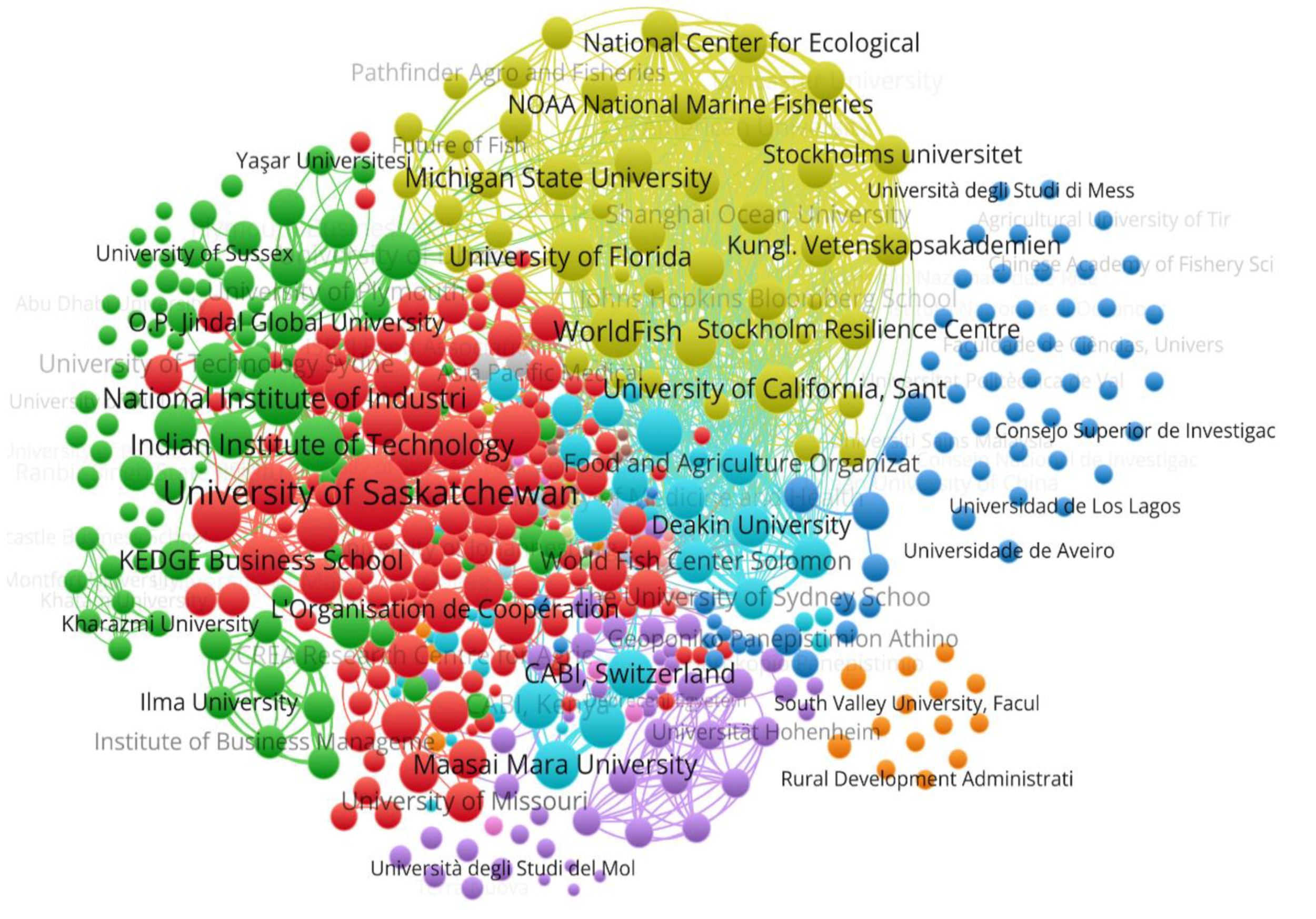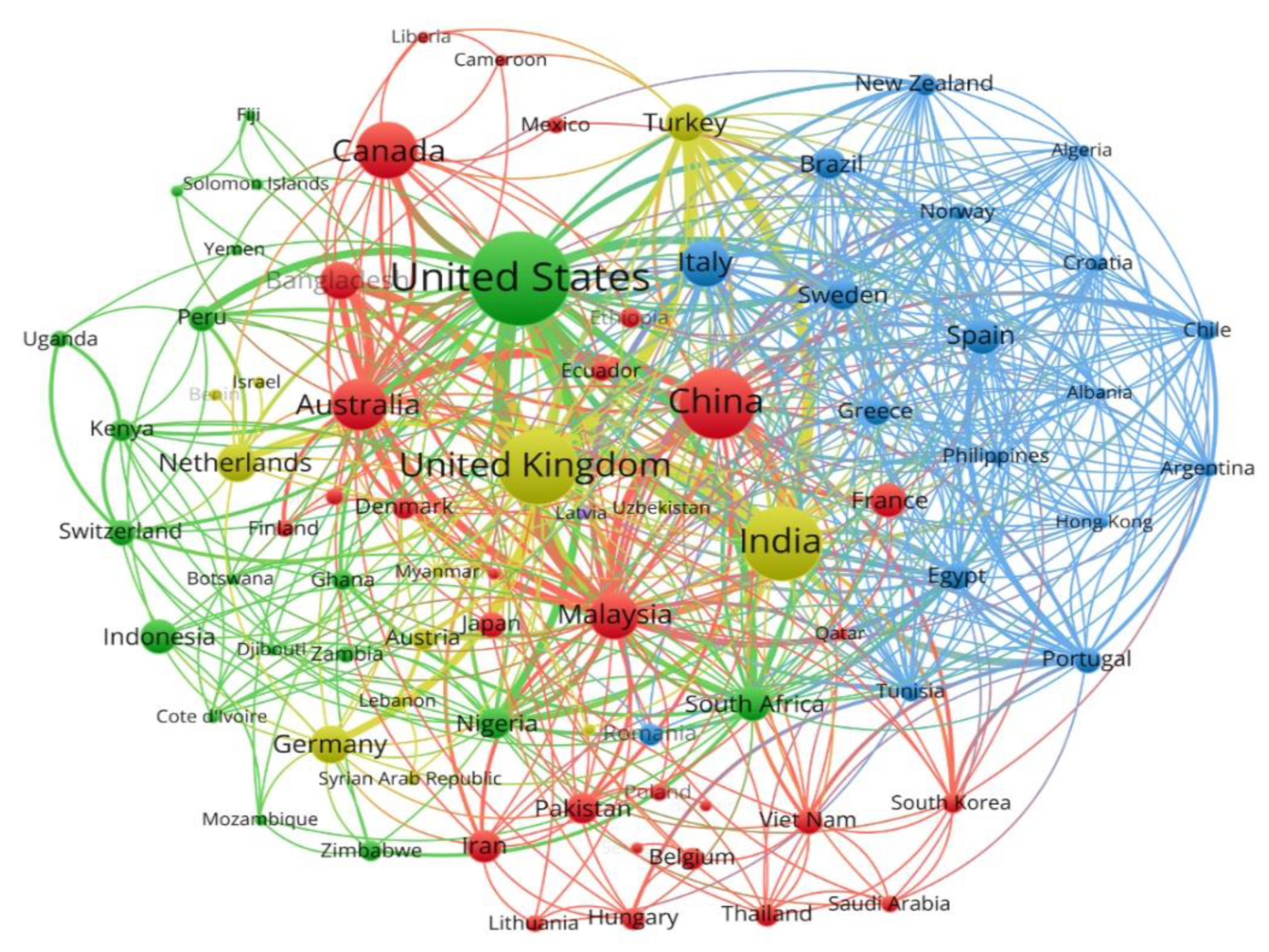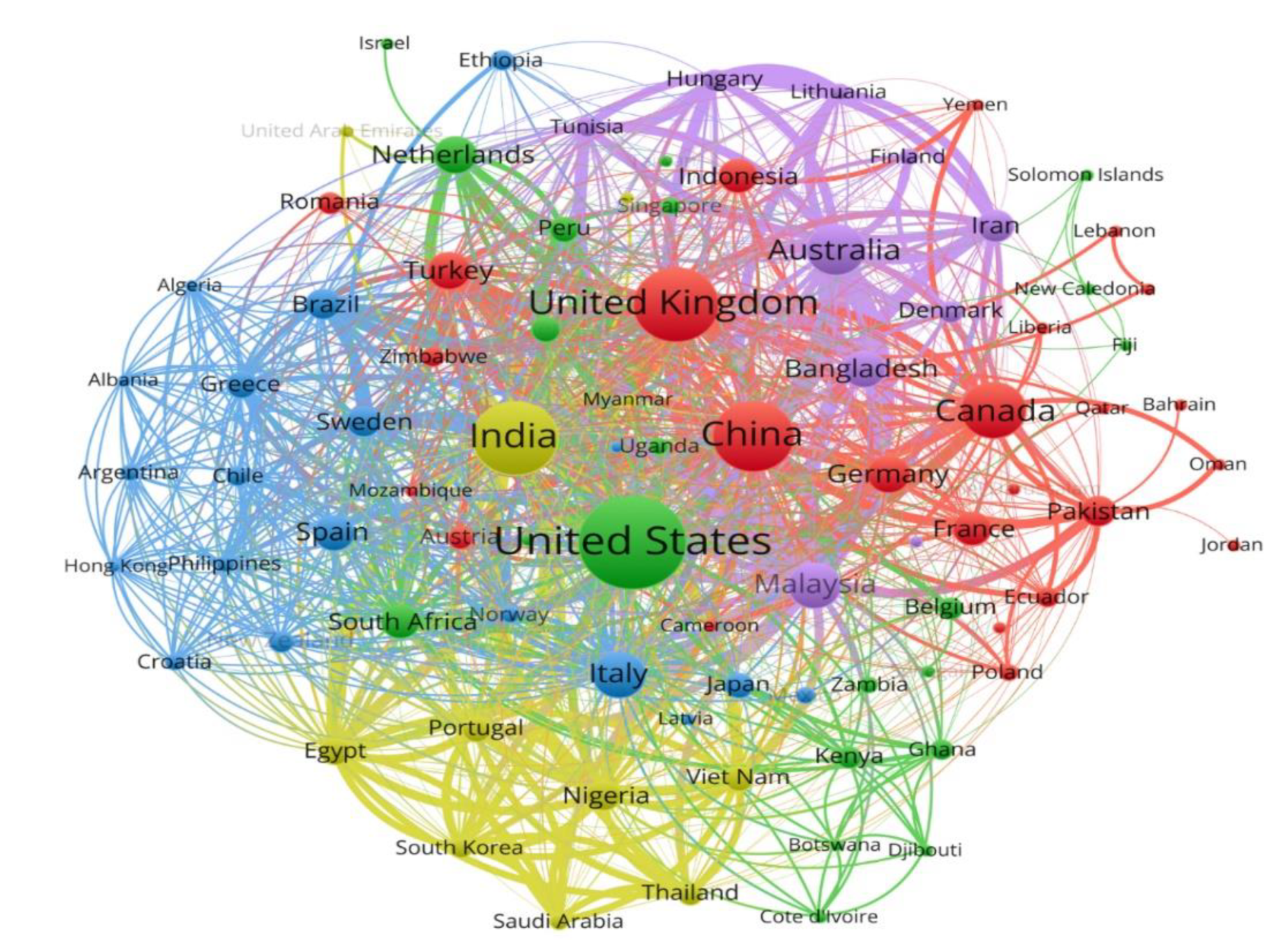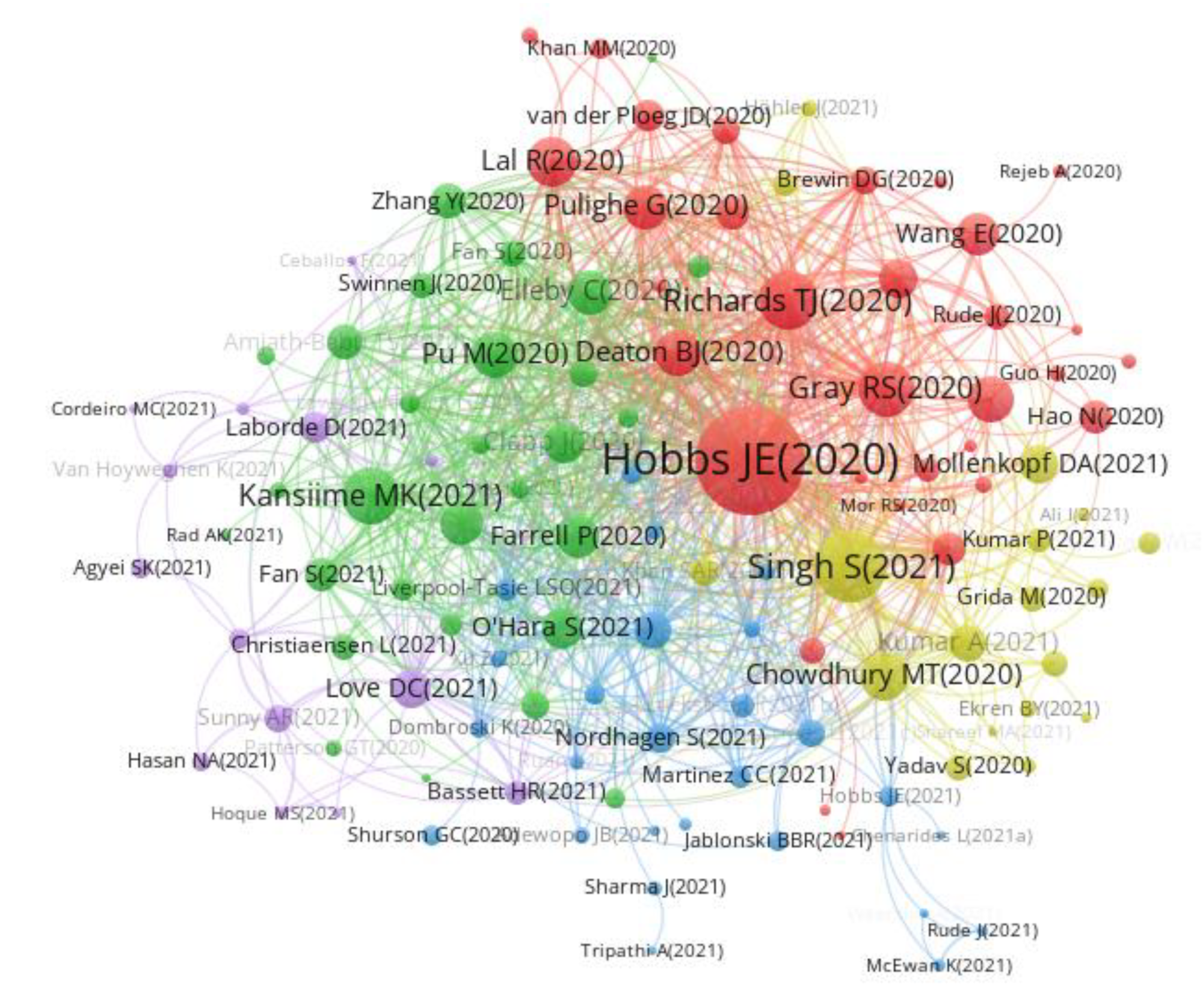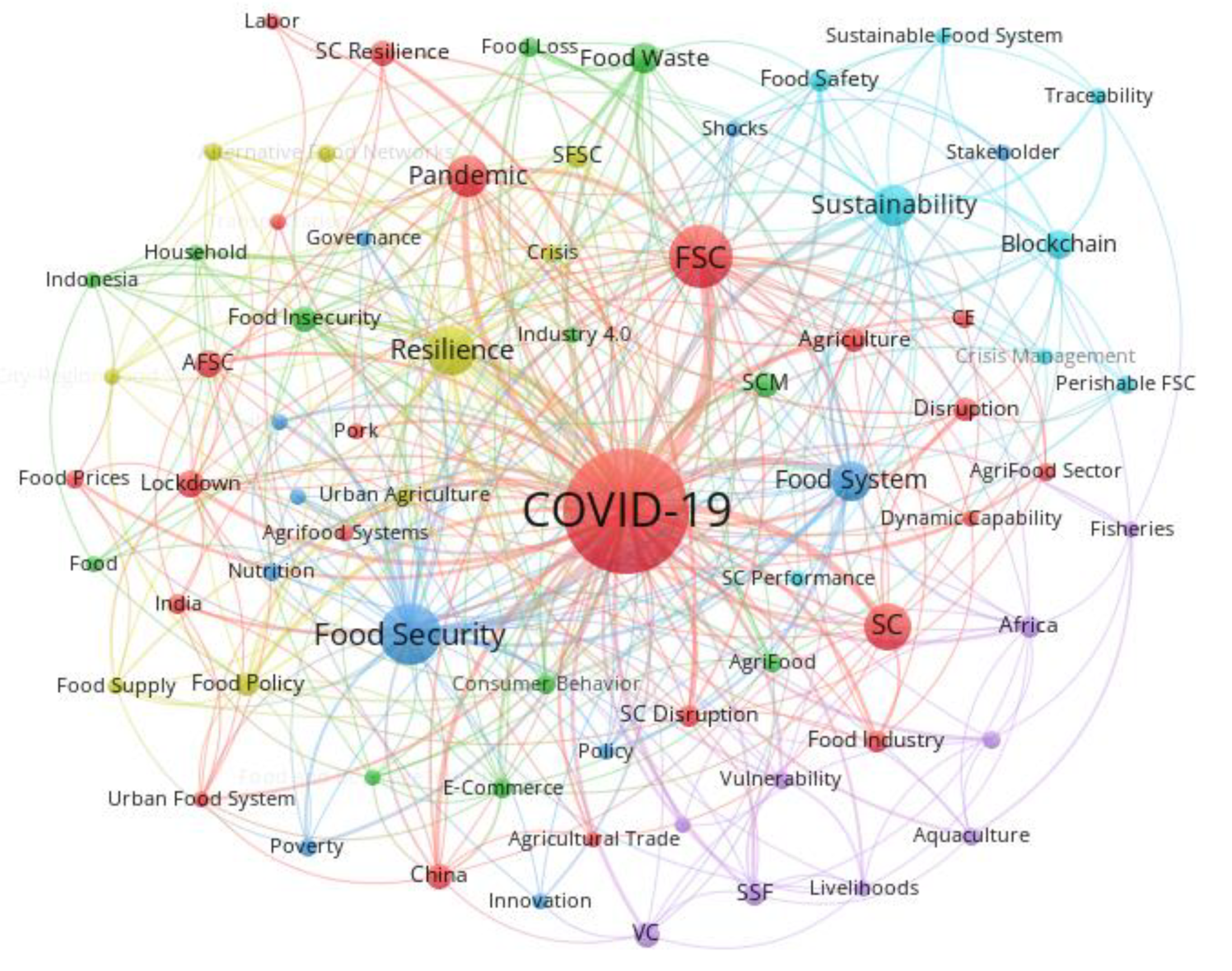1. Introduction
In recent decades, infectious diseases have posed significant challenges, particularly since the onset of the COVID-19 pandemic at the start of 2020 [
1,
2]. As of late 2019, when it was first detected in Wuhan, China, COVID-19 had claimed around six lives worldwide [
3]. The World Health Organization (WHO) named it a new coronavirus illness due to the speed and intensity with which the virus spread worldwide. Without any question, the economic crisis caused by the COVID-19 pandemic has led to a global recession, the likes of which the world has not experienced since the Second World War. The scale of the effect is considerable, owing to globalization [
4]. Many importing nations depend on food exporters to provide crucial food products [
5]. As the severity of COVID-19 rises, food supply chain (FSC) disruptions are expected to be a catastrophe that will surpass the infectious virus [
6,
7,
8].
A balanced diet constitutes a primordial source of sustenance and is required to provide the body with appropriate nutrients in order to increase resilience against illnesses. Healthy nutrition includes micronutrients [
9] that can be obtained by balancing the consumption of animal-based and plant diets [
10]. However, recent research in several countries (e.g., the United Kingdom, Greece, and Chile) indicated that individuals consumed more ultra-processed food products, i.e., those with a high concentration of sugars, fats, and salts during the pandemic [
11]. Moreover, due to the global economic slowdown, low-income families are challenged by the difficulty of buying healthy and nutritious food products, which calls for social measures and protections [
12].
Before COVID-19, developing nations already struggled with unstable and fragile FSC. For instance, Nordhagen et al. [
13] estimates that one in three persons suffers from malnutrition, and one in nine people experiences starvation. These consequences are particularly pronounced in Africa and Asia [
14,
15,
16]. The FSC disruptions and food scarcity directly affect the health and well-being of one-third of the global population.
To facilitate the containment of the coronavirus, authorities across the globe limited human-to-human contact and controlled social distance [
17,
18,
19]. Such actions strained the midstream and downstream segments of the FSC, resulting in a total disruption [
20]. The intermediary market actors play a major role in food distribution, especially in highly populated regions in Asia, whereby they are accountable for the marketability of food products and manage transaction costs made up of logistics activities [
21,
22,
23]. Marketplaces were closed to prevent the transmission of the virus during the pandemic [
20]. In addition to the absence of sellers and buyers, wholesale markets, cold storage facilities, and vegetable stores suffered from labor shortages and were consequently unable to load and unload food deliveries. The FSC disruption is mostly attributable to coercive limits on movement and the unprecedented shutdowns of borders [
24].
In the past two years, the literature on the impact of COVID-19 on the FSC has increased significantly; however, a bibliometric study of the FSC trends in the COVID-19 era is lacking. Unlike traditional reviews, a bibliometric analysis enables researchers to structure, summarize, and quantitatively assess a particular domain’s development using several publications [
25]. Moreover, applying bibliometrics as a quantitative method ensures a non-predetermined and objective examination of an academic field [
26]. Furthermore, bibliometric approaches permit the analysis of a vast array of textual resources; they are more data-driven and hence less biased [
27]. The recent works by Erboz et al. [
28] and Cordeiro et al. [
29] have applied bibliometrics to analyze the general impact of pandemics and COVID-19 on supply chains without focusing on the FSC. As a result, this study focuses on a bibliometric analysis of COVID-19 and the FSC domain to better understand the bibliometric profile of FSC research, the main themes emerging from the literature, and future research directions. Consequently, the value of this work is to offer a timely review of FSC research in the COVID-19 era by employing a bibliometric analysis.
Addressing the aforementioned research gaps, the primary objective of this article is to explore the current status of FSC research in the COVID-19 era and to develop a research agenda for future studies. Our study also focuses on persuading interested researchers to undertake exhaustive, in-depth, and comprehensive works on emerging topics at the nexus of COVID-19 and the FSC. More specifically, this study fills the existing gap in the literature with several questions mainly concentrating on the current FSC research in the COVID-19 era. By doing so, we highlight the most productive scholars and journals that need to be tracked to determine the direction of this knowledge field. Furthermore, through the bibliometric approach, it is possible to identify the geographic distribution of publications in FSC and COVID-19. This is crucial, as it can indicate research progress as well as the technological development of different institutions and countries [
30].
Moreover, identifying key thematic areas in the literature using bibliometric techniques has been left unaddressed. As a result, science mapping is essential to uncover the dynamics and structure of FSC research in the COVID-19 context. Finally, after socially, intellectually, and conceptually structuring the literature, we draw on the findings of the bibliometric analysis to advance FSC knowledge and direct researchers to identify future research possibilities. Therefore, the following are our primary research questions:
Who are the scholars, and what are the journals, academic institutions, and nations contributing to the literature on COVID-19 and the FSC?
In the context of COVID-19 and the FSC, what are the main emerging research themes?
What future research directions are needed to advance the literature related to FSC in the COVID-19 era?
This article is organized as follows.
Section 2 provides the theoretical background of the review.
Section 3 presents the research method applied. Next, the findings from the bibliometric analysis are disclosed.
Section 5 presents the science mapping of the FSC knowledge base during the pandemic.
Section 6 discusses the findings, followed by conclusions in
Section 7.
6. Discussion
The global FSCs are very complex, and the current COVID-19 pandemic has shown how vulnerable they are by disrupting the vital flow of food products from farmers and producers to final consumers. The social and economic effects of the pandemic can be seen all across the world. FSCs have been impacted hard by hazards ranging from humanitarian concerns to an unstable business climate. There has been a particularly serious threat to the food supply throughout the COVID-19 pandemic. The four tenets of food security, namely, accessibility, availability, stability, and utilization [
19], have been severely influenced by the pandemic [
170,
171]. The executive director of the World Food Programme has warned that this global health crisis has the potential to become a famine if nothing is done to stop it. Likewise, disruptions in FSC activities (e.g., production, processing, shipping, distribution, marketing, etc.) have a negative impact on food security and affordability. As a result, to prepare for the future post-COVID-19, the food industry can learn several valuable lessons from the current pandemic. The goal of this paper was to employ bibliometric methods and scientific mapping to investigate the impacts of COVID-19 on the FSC. To this end, 287 papers have been published on the topic of COVID-19’s effect on the FSC, suggesting a rise in the number of articles in this area since 2020. Kazancoglu Y. with five publications, Mangla S.K. with four publications, and others have all contributed significantly to the knowledge of this topic by shedding light on various aspects of the FSC’s dynamics through time. These scholars have established themselves in prominent academic journals devoted to examining the impact of the COVID-19 on the FSC, such as
Sustainability and the
International Journal of Logistics Management. As a result, the editorial boards of journals may want to reach out to the most productive and active scholars to increase awareness of their publications and spark new ideas for research on the FSC and the COVID-19 pandemic. Being cognizant of the most prominent and productive authors within the scientific community can serve as a source of inspiration for new ideas, motivation for teamwork and research collaboration, and impetus for further studies.
The most influential works on COVID-19 and the FSC are those authored by [
92,
93,
94], each of which has received a total of 243, 189, 127 citations, respectively. These influential publications identified in this study can serve as a suitable jumping-off point for scholars, new scholars, and doctoral students who want to learn more about the conceptual underpinnings of FSC research and its evolution with the unfolding of the pandemic.
In addition, WorldFish, with eight publications, followed by the International Food Policy Research Institute and China Agricultural University, with six publications each, have attempted to advance the field by promoting research on the topic. As these institutions have made substantial contributions to FSC research, it would be beneficial for future studies to investigate the factors that contribute to these institutions’ comparatively high levels of scholarly output. In the future, researchers may apply quantitative and qualitative approaches to dig further into the connections between the growing number of FSC-related studies and factors including government policy to counter COVID-19, the economic situation, social issues, and human capital.
The nations that have contributed the most to the body of literature in this area are the United States, India, the United Kingdom, and China, with 66, 42, 41, and 37 publications, respectively. The leading position of these countries can be explained by several reasons. For example, US food insecurity has risen drastically due to the COVID-19 pandemic [
43]. Wolfson and Leung [
172] showed that 44% of the surveyed US participants (n = 1478) had trouble obtaining food products. Moreover, a great interest in the resilience of good systems has been sparked by COVID-19 in the United States, including efforts to comprehend how players across the FSC reacted to this systemic disruption, with an eye toward improving the food system’s resilience in the face of such threats in the future [
173]. Despite being the major producer of numerous food products and commodities and also maintaining a well-structured legislative and institutional system for food distribution, India has faced several challenges, such as food insecurity, hunger, and food losses, during the pandemic [
174]. Firms operating in the perishable FSC in India have been under a lot of pressure because of the potential threats to their activities posed by the pandemic, including the unpredictability in demand and supply, insufficient logistics, questionable information credibility, the suspension of economic operations, and the closing of markets [
105]. Overall, most of the productive nations enjoy high scholarly influence; thus, global research cooperation should be promoted, particularly for scholars in developing countries. In line with the contention of Narin et al. [
175], we posit that excellent research is inherently global. Therefore, researcher mobility may be encouraged to broaden participation in international research cooperation networks, enhance research quality, and strengthen international research partnerships.
The construction of the reference co-citation network results in the formation of four clusters. The focus of the first cluster is on the general impact of the COVID-19 pandemic on FSC systems and agriculture. The literature can be further extended to consider the impact of climate-related crises [
137] and the Russia-Ukraine conflict on global FSCs during the pandemic [
176]. The second cluster explored the mitigation strategies and measures required to improve FSC resilience. These include proactive business continuing planning, collaborative management, and financial sustainability [
105]. The literature in the second cluster can be broadened by exploring the role of new technologies such as blockchain technology, artificial intelligence, big data analytics, the internet of things, and additive manufacturing in reducing FSC disruption and increasing the sustainability of the food sector [
139].
Other research includes the examination of the resilience elements in different FSC operations and possible strategies to enhance organizational flexibility, create redundancy, improve supply chain agility, and strengthen inter-firm collaborations [
142]. The third cluster revolves around the risks of the COVID-19 pandemic to worldwide food security. From the perspective of this literature, future studies need to develop food security response policy frameworks to offer solutions for efficiently managing COVID-19 and any such public health situations in the future [
138]. The final cluster is essentially related to the influence of the pandemic on seafood systems. According to the literature stream in this cluster, it would be worthwhile to explore the types of necessary responses to absorb COVID-19 disruptions and restore the normal functioning of seafood systems [
111]. Research can also provide a set of tools for future practitioners in the fishing industry to develop various monitoring approaches for fisheries’ supply chains with the help of emerging technologies. This is crucial to respond to fluctuations in product supply and demand and increase the efficiency of special storage of live or perishable seafood products [
21].
The analysis of journal co-citations enables us to tease out three distant clusters with a focus on logistics and supply chain management, food sciences and agriculture, and sustainability. As a result, it is recommended that future researchers publish in journals from their own field and from other disciplines (e.g., marketing, psychology, etc.) to contextualize their findings and advance the multidisciplinary nature of FSC research in the COVID-19 era. Furthermore, the analysis of journal co-citation networks and country co-authorship suggests the need for stronger research collaboration across institutions and countries to enhance research output, quality, and influence. The analysis of the countries’ bibliographic coupling network also reveals six clusters capturing the research similarities between countries.
To complement the results of the reference co-citation analysis, we analyzed the results of the article co-citation network. According to this approach, five research clusters were identified with at least one co-citation. The majority of these clusters consisted of the works of Kazancoglu Y. The first cluster concerns the impacts of COVID-19 on the FSC and urban agriculture. The pandemic has prompted discussions about transitioning from relying on long food supply channels to relying on shorter, more local supply channels, such as urban agriculture [
151]. The importance of urban agriculture is attributed to several factors, including its role in addressing food security issues and the efficiency of urban agriculture systems in terms of yield per unit area, nutritional value, and short growing seasons [
54]. As a result, the growing relevance of cutting-edge agriculture technology in today’s urban agriculture has to be emphasized, and educational institutions should play a vital role in preparing the next generation of farmers. Awareness of the significance of this approach, especially for urban food security during pandemics, must be created and maintained via the combined efforts of researchers, government agencies, and academic institutions. Future research should be also devoted to understanding how the long-term collaboration between the private sector, the education sector, and government agencies can promote advanced technologies in urban agriculture and ensure the participation of the urban community in these types of activities.
The second cluster is related to the implications of the pandemic on household income and food security. According to Béné [
135], the economic repercussions of the lockdown and movement restrictions are as much important as COVID-19 fatalities, in terms of the security and negative effects of the pandemic. Measures intended to restrict the transmission of the virus have affected household income and FSC activities, including production, transportation, and logistics, thereby resulting in recurrent food price hikes and food insecurity. Related to this cluster theme, future studies can evaluate the impact of pandemics in terms of the trade-off between the health advantages of preventing the transmission of viruses and the severe economic consequences for vulnerable communities and food-insecure families [
136]. There is also a need to understand how a limited household income can impact food choices and demand during pandemics [
58]. The third cluster sheds light on the FSC disruptions caused by the pandemic in developing nations. Even though the spread of COVID-19 has affected most countries, the pandemic’s effects on FSCs in developing and impoverished nations threaten to exacerbate food security and the plight of the poor, who mostly rely on agriculture.
According to Jribi et al. [
177], the pandemic has had major effects on developing countries’ ability to reach sustainable development goals, especially regarding ending hunger (SDG2) and ensuring sustainable consumption and production patterns (E12). Consequently, future researchers should address the lack of studies examining the impact of the pandemic on small and medium food enterprises in developing countries [
178]. Furthermore, measures and strategies to increase developing countries’ preparedness for similar catastrophes deserve further attention considering resource scarcity, inflation rates, and economic difficulties [
4]. Finally, the articles in the fourth and fifth clusters discuss the risk mitigation strategies to boost FSC resilience and the impact of the pandemic on seafood systems. These themes overlap with the findings of the reference co-citation analysis; thus, the same future research directions apply to these clusters.
Keyword analysis of the selected publications yielded six distinct clusters. The articles in the first cluster, labeled “The impact of COVID-19 on the FSC and agriculture“, discuss the disruptions caused by the pandemic in the FSC in terms of food supply, labor shortage, and limited sourcing of raw materials. The second cluster, labeled “FSC resilience”, contains articles that discuss the need to increase resilience to combat the adverse implications of the pandemic in the food industry. Organizations are incentivized to improve their supply chain resilience to prepare for potential unforeseen events associated with the pandemic and to recover from disruptions while keeping operations running as usual. The third cluster, “Food waste and insecurity”, highlights the increase in food waste and insecurity during the COVID-19 pandemic due to changes in consumer behavior and lifestyle habits. The fourth cluster, which is labeled “Fisheries and aquaculture”, deals with the impact of the pandemic on fisheries and aquaculture activities. Farmers are the participants who are most exposed to the disruptions of the pandemic, since they are responsible for a substantial financial investment that is subject to a wide range of potential hazards, lower production, higher mortality of fishers, and market fluctuations. The fifth cluster relates to the potential of blockchain for developing sustainable and traceable FSCs during the COVID-19 pandemic. Finally, the sixth cluster contains articles that discuss governance and innovation as a means to withstand the different sets of constraints that the pandemic has placed on FSCs. In addition to the in-depth analysis of these clusters, several knowledge gaps and future research opportunities were highlighted.
In a nutshell, FSC research has drawn a great deal of interest from various parties, including academics, universities, and research centers. As far as the authors are aware, this is the first study to attempt to map out the intellectual structure of the FSC research during the COVID-19 pandemic and the outcomes accomplished so far. Researchers in various academic fields can benefit from a deeper knowledge of the numerous perspectives that have shaped the intersection of FSC research and COVID-19. Researchers can also seek guidance from this study to learn about the current knowledge gaps and potential research directions. Our research may help them to initiate fruitful research collaboration and identify the most suitable journals for their topics. The bibliometric approach can benefit academics and students at the PhD level, who may use the present findings to learn more about the FSC literature and investigate FSC-related issues in more depth.
7. Conclusions, Implications, and Limitations
The major goal of this article is to provide a synopsis of recent works on FSC research in the COVID-19 context and contribute to the body of knowledge by identifying several gaps and directions for future studies. With the help of bibliometric techniques and a qualitative evaluation of the selected publications, we have determined the most prominent areas of study and uncovered new and exciting directions for future research. In total, 287 publications from peer-reviewed journals were reviewed for this study using performance analysis and science mapping. Based on the initial statistics and the performance analysis—the publications’ trend, the most productive journals, authors’ productivity and influence, the most productive institutions and countries, the most frequent keywords, and the most influential publications are just a few of the indicators that can be utilized to characterize the current state of the FSC literature in the COVID-19 era. Furthermore, the science mapping analysis reveals several insights regarding reference co-citations, journal co-citations, institution co-citations, countries’ co-authorships, countries’ bibliographic coupling, article co-citations, and keyword co-occurrence.
Researchers looking into the effects of the COVID-19 pandemic on the FSC may find the review findings useful. However, a lack of studies that provide a comprehensive analysis of COVID-19 in the context of the FSC stands in contrast to the plethora of literature on the subject of the pandemic itself. Consequently, we set out to research the nexus of the COVID-19 pandemic and the FSC to address this knowledge gap.
This study helps scholars, practitioners, and decision-makers comprehend the impact of COVID-19 on the performance of the FSC and draws their attention to the scholarly production, trends, and prospects for developing more sustainable and resilient FSCs to combat the current pandemic. Our findings will aid scholars who are interested in gaining a complete picture of the state of FSC research in the COVID-19 era and the areas that still need inquiry. According to the keyword co-occurrence network results, existing research mostly focuses on the impact of the pandemic on FSC, resilience, and food waste and insecurity. Therefore, researchers should explore practical solutions to ensure FSC resilience, reduce food waste, and increase food security and availability. Furthermore, researchers can improve collaboration with scholars and learn from the most prolific scholars if they can identify the most productive contributors in the research area of COVID-19 and the FSC. In addition, the foundational works identified in this review can provide entry points for scholars interested in exploring under-researched facets of FSC research in the pandemic era.
Moreover, clustering the relevant literature based on the keyword co-occurrence approach reveals the fundamental topics of FSC research and highlights important gaps in our understanding. Blockchain technology, governance, and innovation are also topical areas of FSC research, which compose the fifth and sixth clusters. The role of emerging technologies is evident in minimizing food waste and accelerating the transition toward more sustainable and circular FSCs. As a result, understanding the organizational objectives, operations, and corporate environment can assist practitioners in determining the appropriate business context in which technology-enabled FSCs can be implemented to fight the COVID-19 pandemic. To summarize, the present study adopts a unique approach to synthesizing FSC research in the COVID-19 era, drawing on bibliometric techniques to produce a quantifiable and objective evaluation of the current status of the FSC literature. Despite the growing interest in the impact of COVID-19 on the food industry, to the best of our knowledge, no dedicated and thorough review of FSC research has been published during the ongoing pandemic. Our investigation of the state of the research on this topic and the knowledge gaps can encourage the launch of new investigations and boost international academic output on FSC research in the COVID-19 era.
Despite its significant contribution, a number of caveats exist in this study. One major limitation was that we only used journal articles in the Scopus database. Future studies can include other types of publications (e.g., conference papers, books, chapters, etc.) and alternative scientific databases (e.g., the Web of Science) to confirm and eventually expand our review findings by unpacking new insights, research perspectives, and trends. Furthermore, our literature analysis is limited to visualizing and tracing FSC research during the COVID-19 era. The results of this review should be supplemented by a detailed systematic or bibliometric literature review that compares the impacts of the pandemic on the food industry and other economic sectors (e.g., the automotive sector). Finally, clustering the literature based on bibliographic coupling can be considered in future studies, because this approach is static and retrospective. Unlike co-citation analysis, which is a dynamic and forward-looking approach [
27], bibliographic coupling may provide different clustering outcomes.
